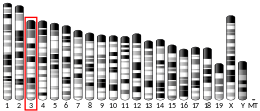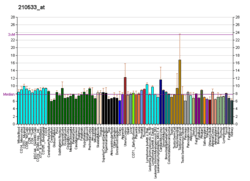MSH4
MutS protein homolog 4 is a protein that in humans is encoded by the MSH4 gene.[5][6]
Function
The MSH4 and MSH5 proteins form a hetero-oligomeric structure (heterodimer) in yeast and humans.[7][8][9] In the yeast Saccharomyces cerevisiae MSH4 and MSH5 act specifically to facilitate crossovers between homologous chromosomes during meiosis.[7] The MSH4/MSH5 complex binds and stabilizes double Holliday junctions and promotes their resolution into crossover products. An MSH4 hypomorphic (partially functional) mutant of S. cerevisiae showed a 30% genome wide reduction in crossover numbers, and a large number of meioses with non exchange chromosomes.[10] Nevertheless this mutant gave rise to spore viability patterns suggesting that segregation of non-exchange chromosomes occurred efficiently. Thus, in S. cerevisiae, proper segregation apparently does not entirely depend on crossovers between homologous pairs.
The him-14 gene of the worm Caenorhabditis elegans encodes an ortholog of MSH4.[11] Formation of crossovers during C. elegans meiosis requires the him-14(MSH4) gene. Loss of him-14(MSH-4) function severely reduces crossing over, resulting in lack of chiasmata between homologs and consequent missegregation. Thus, in C. elegans, segregation apparently does depend on crossovers between homologous pairs. Him-14(MSH4) functions during the pachytene stage of meiosis, indicating that it is not needed for establishing the preceding stages of pairing and synapsis of homologous chromosomes.
In an MSH4 mutant of rice, chiasma frequency was dramatically decreased to about 10% of the wild-type frequency, although the synaptonemal complex was normally installed.[12] It is likely that MSH4 interacts with MSH5 to promote the majority of crossovers during rice meiosis.
In general it appears that MSH4 acts during meiosis to direct the recombinational repair of some DNA double-strand breaks towards the crossover option rather than the non-cross over option (see Homologous recombination).
Interactions
MSH4 has been shown to interact with MLH1,[13] MSH5[8][9][14] and MLH3.[15]
References
- GRCh38: Ensembl release 89: ENSG00000057468 - Ensembl, May 2017
- GRCm38: Ensembl release 89: ENSMUSG00000005493 - Ensembl, May 2017
- "Human PubMed Reference:". National Center for Biotechnology Information, U.S. National Library of Medicine.
- "Mouse PubMed Reference:". National Center for Biotechnology Information, U.S. National Library of Medicine.
- Paquis-Flucklinger V, Santucci-Darmanin S, Paul R, Saunières A, Turc-Carel C, Desnuelle C (Sep 1997). "Cloning and expression analysis of a meiosis-specific MutS homolog: the human MSH4 gene". Genomics. 44 (2): 188–94. doi:10.1006/geno.1997.4857. PMID 9299235.
- "Entrez Gene: MSH4 mutS homolog 4 (E. coli)".
- Pochart P, Woltering D, Hollingsworth NM (1997). "Conserved properties between functionally distinct MutS homologs in yeast". J. Biol. Chem. 272 (48): 30345–9. doi:10.1074/jbc.272.48.30345. PMID 9374523.
- Winand NJ, Panzer JA, Kolodner RD (1998). "Cloning and characterization of the human and Caenorhabditis elegans homologs of the Saccharomyces cerevisiae MSH5 gene". Genomics. 53 (1): 69–80. doi:10.1006/geno.1998.5447. PMID 9787078.
- Bocker T, Barusevicius A, Snowden T, Rasio D, Guerrette S, Robbins D, Schmidt C, Burczak J, Croce CM, Copeland T, Kovatich AJ, Fishel R (1999). "hMSH5: a human MutS homologue that forms a novel heterodimer with hMSH4 and is expressed during spermatogenesis". Cancer Res. 59 (4): 816–22. PMID 10029069.
- Krishnaprasad GN, Anand MT, Lin G, Tekkedil MM, Steinmetz LM, Nishant KT (2015). "Variation in crossover frequencies perturb crossover assurance without affecting meiotic chromosome segregation in Saccharomyces cerevisiae". Genetics. 199 (2): 399–412. doi:10.1534/genetics.114.172320. PMC 4317650. PMID 25467183.
- Zalevsky J, MacQueen AJ, Duffy JB, Kemphues KJ, Villeneuve AM (1999). "Crossing over during Caenorhabditis elegans meiosis requires a conserved MutS-based pathway that is partially dispensable in budding yeast". Genetics. 153 (3): 1271–83. PMC 1460811. PMID 10545458.
- Zhang L, Tang D, Luo Q, Chen X, Wang H, Li Y, Cheng Z (2014). "Crossover formation during rice meiosis relies on interaction of OsMSH4 and OsMSH5". Genetics. 198 (4): 1447–56. doi:10.1534/genetics.114.168732. PMC 4256764. PMID 25278554.
- Santucci-Darmanin S, Walpita D, Lespinasse F, Desnuelle C, Ashley T, Paquis-Flucklinger V (Aug 2000). "MSH4 acts in conjunction with MLH1 during mammalian meiosis". FASEB Journal. 14 (11): 1539–47. doi:10.1096/fj.14.11.1539. PMID 10928988.
- Her C, Wu X, Griswold MD, Zhou F (Feb 2003). "Human MutS homologue MSH4 physically interacts with von Hippel-Lindau tumor suppressor-binding protein 1". Cancer Research. 63 (4): 865–72. PMID 12591739.
- Santucci-Darmanin S, Neyton S, Lespinasse F, Saunières A, Gaudray P, Paquis-Flucklinger V (Jul 2002). "The DNA mismatch-repair MLH3 protein interacts with MSH4 in meiotic cells, supporting a role for this MutL homolog in mammalian meiotic recombination". Human Molecular Genetics. 11 (15): 1697–706. CiteSeerX 10.1.1.586.4478. doi:10.1093/hmg/11.15.1697. PMID 12095912.
Further reading
- Her C, Zhao N, Wu X, Tompkins JD (2007). "MutS homologues hMSH4 and hMSH5: diverse functional implications in humans". Frontiers in Bioscience. 12: 905–11. doi:10.2741/2112. PMID 17127347.
- Winand NJ, Panzer JA, Kolodner RD (Oct 1998). "Cloning and characterization of the human and Caenorhabditis elegans homologs of the Saccharomyces cerevisiae MSH5 gene". Genomics. 53 (1): 69–80. doi:10.1006/geno.1998.5447. PMID 9787078.
- Bocker T, Barusevicius A, Snowden T, Rasio D, Guerrette S, Robbins D, Schmidt C, Burczak J, Croce CM, Copeland T, Kovatich AJ, Fishel R (Feb 1999). "hMSH5: a human MutS homologue that forms a novel heterodimer with hMSH4 and is expressed during spermatogenesis". Cancer Research. 59 (4): 816–22. PMID 10029069.
- Kneitz B, Cohen PE, Avdievich E, Zhu L, Kane MF, Hou H, Kolodner RD, Kucherlapati R, Pollard JW, Edelmann W (May 2000). "MutS homolog 4 localization to meiotic chromosomes is required for chromosome pairing during meiosis in male and female mice". Genes & Development. 14 (9): 1085–97. PMC 316572. PMID 10809667.
- Santucci-Darmanin S, Walpita D, Lespinasse F, Desnuelle C, Ashley T, Paquis-Flucklinger V (Aug 2000). "MSH4 acts in conjunction with MLH1 during mammalian meiosis". FASEB Journal. 14 (11): 1539–47. doi:10.1096/fj.14.11.1539. PMID 10928988.
- Räschle M, Dufner P, Marra G, Jiricny J (Jun 2002). "Mutations within the hMLH1 and hPMS2 subunits of the human MutLalpha mismatch repair factor affect its ATPase activity, but not its ability to interact with hMutSalpha". The Journal of Biological Chemistry. 277 (24): 21810–20. doi:10.1074/jbc.M108787200. PMID 11948175.
- Moens PB, Kolas NK, Tarsounas M, Marcon E, Cohen PE, Spyropoulos B (Apr 2002). "The time course and chromosomal localization of recombination-related proteins at meiosis in the mouse are compatible with models that can resolve the early DNA-DNA interactions without reciprocal recombination". Journal of Cell Science. 115 (Pt 8): 1611–22. PMID 11950880.
- Santucci-Darmanin S, Neyton S, Lespinasse F, Saunières A, Gaudray P, Paquis-Flucklinger V (Jul 2002). "The DNA mismatch-repair MLH3 protein interacts with MSH4 in meiotic cells, supporting a role for this MutL homolog in mammalian meiotic recombination". Human Molecular Genetics. 11 (15): 1697–706. CiteSeerX 10.1.1.586.4478. doi:10.1093/hmg/11.15.1697. PMID 12095912.
- Her C, Wu X, Griswold MD, Zhou F (Feb 2003). "Human MutS homologue MSH4 physically interacts with von Hippel-Lindau tumor suppressor-binding protein 1". Cancer Research. 63 (4): 865–72. PMID 12591739.
- Snowden T, Acharya S, Butz C, Berardini M, Fishel R (Aug 2004). "hMSH4-hMSH5 recognizes Holliday Junctions and forms a meiosis-specific sliding clamp that embraces homologous chromosomes". Molecular Cell. 15 (3): 437–51. doi:10.1016/j.molcel.2004.06.040. PMID 15304223.
- Yi W, Wu X, Lee TH, Doggett NA, Her C (Jul 2005). "Two variants of MutS homolog hMSH5: prevalence in humans and effects on protein interaction". Biochemical and Biophysical Research Communications. 332 (2): 524–32. doi:10.1016/j.bbrc.2005.04.154. PMID 15907804.
- Lee TH, Yi W, Griswold MD, Zhu F, Her C (Jan 2006). "Formation of hMSH4-hMSH5 heterocomplex is a prerequisite for subsequent GPS2 recruitment". DNA Repair. 5 (1): 32–42. doi:10.1016/j.dnarep.2005.07.004. PMID 16122992.
- Rual JF, Venkatesan K, Hao T, Hirozane-Kishikawa T, Dricot A, Li N, Berriz GF, Gibbons FD, Dreze M, Ayivi-Guedehoussou N, Klitgord N, Simon C, Boxem M, Milstein S, Rosenberg J, Goldberg DS, Zhang LV, Wong SL, Franklin G, Li S, Albala JS, Lim J, Fraughton C, Llamosas E, Cevik S, Bex C, Lamesch P, Sikorski RS, Vandenhaute J, Zoghbi HY, Smolyar A, Bosak S, Sequerra R, Doucette-Stamm L, Cusick ME, Hill DE, Roth FP, Vidal M (Oct 2005). "Towards a proteome-scale map of the human protein-protein interaction network". Nature. 437 (7062): 1173–8. doi:10.1038/nature04209. PMID 16189514.
- Neyton S, Lespinasse F, Lahaye F, Staccini P, Paquis-Flucklinger V, Santucci-Darmanin S (Oct 2007). "CRM1-dependent nuclear export and dimerization with hMSH5 contribute to the regulation of hMSH4 subcellular localization". Experimental Cell Research. 313 (17): 3680–93. doi:10.1016/j.yexcr.2007.08.010. PMID 17869244.
External links
- FAQs on HNPCC from the National Institute of Health
- GeneReviews/NCBI/NIH/UW entry on Lynch syndrome




